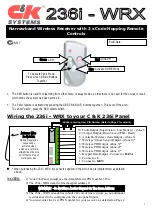
2
MDS 9810 Installation and Operation Guide
MDS 05-3301A01, Rev. C
Transceiver Features
Listed below are several key features of the transceiver. These are
designed to ease the installation and configuration of the radio, while
retaining the ability to make changes in the future.
• 1,019 frequencies over 902–928 MHz, subdivided into eight
frequency zones
• Configurable operating zones to omit frequencies with constant
interference
• 65,000 available network addresses
• Network-wide configuration from the master station; eliminates
most trips to remote sites
• Data transparency–ensures compatibility with virtually all
asynchronous SCADA system RTUs
• Peak-hold RSSI, averaged over eight hop cycles
• Operation at up to 19200 bps continuous data flow;
38400 bps non-continuous
• Same hardware for all supported data rates:
1200, 2400, 4800, 9600, 19200, 38400 bps asynchronous
• Same hardware for master or remote configuration
• Data latency typically less than 10 ms
• Supports EIA-232 (formerly called RS-232) user interface
• Low current consumption–30 mA or less average draw in
“sleep” mode.
Model Configuration Codes
The radio model number is printed on the end of the radio enclosure, and
provides key information about how the radio was configured when it
left the factory. See Figure 2 for an explanation of the model number
characters.
Invisible place holder
Figure 2. Transceiver Model Configuration Codes
98
PACKAGE
1= Transceiver only
OPERATION
X= Remote/Master
POWER SETTING
1= 10.5 - 30 Vdc*
DIAGNOSTICS
0= None
1= Non-Intrusive
N= N/A
SAFETY APPROVAL
N= N/A
MOUNTING BRACKETS
A= Standard
B= None
0 X N
AGENCY APPROVAL
F= FCC/IC
U= FM/UL/CSA
* Units shipped prior to Revision “U” (November 1999) may be configured for 25 Vdc maximum DC input.
THIS INFORMATION IS
SUBJECT TO CHANGE.
DO NOT USE FOR
PRODUCT ORDERING.











































